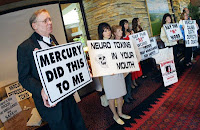Estudios han documentado que el mercurio provoca:
- hipotiroidismo (1,2,3,4),
- daño el RNA de la iroides ,
- tiroiditis autoinmune (4, 5,),
- Deterioro de la conversión de la hormona tiroidea T4 a la forma activa T3. (3,4,5,6).
Estos estudios y la experiencia clínica indican que el mercurio y las exposiciones de metales tóxicos parecen ser la causa más común de hipotiroidismo y la mayoría de los pacientes tratados con desintoxicación por metales recuperan o mejorar de manera significativa (7).
Miles de pruebas en los laboratorios médicos y muchos estudios han documentado que la amalgama dental es la mayor fuente de mercurio en la mayoría de los adultos que tienen varios empastes de amalgama, con exposiciones muy por encima de las directrices gubernamentales de salud (8).
Los estudios también han documentado que la mayoría de las madres que tienen varios empastes de amalgama, los empastes dentales de la madre son la mayor fuente de mercurio en el feto y en una fuente importante de niños (9).
El Mercurio (especialmente de vapor de mercurio de la amalgama dental o mercurio orgánico) cruza rápidamente la barrera hematoencefálica y se almacena preferentemente en la glándula pituitaria, glándula tiroides, hipotálamo, corteza occipital y en proporción directa a la cantidad y extensión de las superficies dentales de amalgama, y del mismo modo cruza rápidamente la placenta y se acumula en el feto incluyendo el cerebro fetal y glándulas hormonales a niveles comúnmente más altos que el nivel en la madre.
El mercurio puede tener efectos significativos sobre la función tiroidea a pesar de que los principales niveles de esta hormona permanecen en el rango normal, por lo que los exámenes de la tiroides habituales no son adecuados en tales casos. La exposición prenatal al metilmercurio afecta severamente la actividad de selenoenzimas, incluyendo glutatión peroxidasa (GPx) y deiodinasas 5 yodotironina (5-Di y 5′-DI) en el cerebro fetal, a pesar de que los niveles de tiroxina (T4) son normales. Otro mecanismo por el cual el mercurio ejerce tales efectos es que el contenido de mercurio afecta los niveles de selenio que se requieren para la conversión de T4 a T3 (10).
 |
| Personas aquejadas por Intoxicación crónica de Mercurio |
Los minerales como calcio, zinc, y manganeso también son necesarios para la salud y la producción de la hormona tiroidea, y su absorción es bloqueada por la exposición al mercurio.
Referencias:
- (a)Sin YM, Teh WF, Wong MK, Reddy PK – “Effect of Mercury on Glutathione and Thyroid Hormones” Bulletin of Environmental Contamination and Toxicology 44(4):616-622 (1990); & (b)J.Kawada et al, “Effects of inorganic and methyl mercury on thyroidal function”, J Pharmacobiodyn, 1980, 3(3):149-59; &(c) Ghosh N. Thyrotoxicity of cadmium and mercury. Biomed EnvironSci 1992, 5(3): 236-40; & (d) Kabuto M – “Chronic effects of methylmercury on the urinary excretion of catecholamines and their responses to hypoglycemic stress” Arch Toxicol 65(2):164-7 (1991)
- (a)J.C.Veltman et al, “Alterations of heme, cytochrome P-450, and steroid metabolism by mercury in rat adrenal gland”, Arch Biochem Biophys, 1986, 248(2):467-78; &(b) Alfred V. Zamm. Dental Mercury: A Factor that Aggravates and Induces Xenobiotic Intolerance. J. Orthmol. Med. v6#2 pp67-77 (1991); & (d) Nishida M, Muraoka K, et al, Differential effects of methylmercuric chloride and mercuric chloride on the histochemistry of rat thyroid peroxidase and the thyroid peroxidase activity of isolated pig thyroid cells. J Histochem Cytochem. 1989 May;37(5):723-7
- (a) Ellingsen DG, Efskind J, Haug E, Thomassen Y, Martinsen I, Gaarder PI – “Effects of low mercury vapour exposure on the thyroid function in chloralkali workers” J Appl Toxicol 20(6):483-9 (2000) , & (b) Barregard L, Lindstedt G, Schutz A, Sallsten G – “Endocrine function in mercury exposed chloralkali workers” Occup Environ Med 51(8):536-40 (1994) www.ncbi.nlm.nih.gov/htbin-post/Entrez/query?uid= 7951778&form=6&db=m&Dopt=r ; & (e) Watanabe C, Yoshida K, Kasanuma Y, Kun Y, Satoh H. In utero methylmercury exposure differentially affects the activities of selenoenzymes in the fetal mouse brain.. Environ Res 1999 Apr;80(3):208-14.
- Autism: transient in utero hypothyroxinemia related to maternal flavonoid ingestion during pregnancy and to other environmental antithyroid agents. J Neurol Sci. 2007 Nov 15;262(1-2):15-26. Epub 2007 Jul 24.. Román GC.
- Sterzl I, Fucikova T, Zamrazil V. The fatigue syndrome in autoimmune thyroiditis with polyglandular activation of autoimmunity. Vnitrni Lekarstvi 1998; 44: 456-60. www.melisa.org ; &(b) Sterzl I, Hrda P, Prochazkova J, Bartova J, Reactions to metals in patients with chronic fatigue and autoimmune endocrinopathy. Vnitr Lek 1999 Sep;45(9):527‑31 ; &(c) The beneficial effect of amalgam replacement on health in patients with autoimmunity. Prochazkova J, Sterzl I, Kucerova H, Bartova J, Stejskal VD; Neuro Endocrinol Lett. 2004 Jun;25(3):211-8.
- Kabuto M – “Chronic effects of methylmercury on the urinary excretion of catecholamines and their responses to hypoglycemic stress” Arch Toxicol 65(2):164-7 (1991)
- Summary of results of treatment of chronic health conditions by amalgam replacement, as reported to the FDA and treatment clinics, www.flcv.com/hgrecovp.html
- Review: Documentation of common mercury exposure levels from amalgam by medical labs, Government agency studies, peer-reviewed studies. B Windham (Ed),www.flcv.com/damspr1.html & www.flcv.com/amalno1.html
- Effects of prenatal and neonatal mercury exposure on children, B Windham(Ed), over 150 peer-reviewed studies, www.flcv.com/fetaln.html
- Selenium and antioxidant defenses as major mediators in the development of chronic heart failure. Heart Fail Rev. 2006 Mar;11(1):13-7. de Lorgeril M, Salen P.


